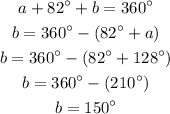Answer:

Step-by-step explanation:
Given the figure in the attached image.
We want to solve for a,b and c;
From the Geometry of circles, the inscribed angle is half the angle on the intercepted arc;

So, we have;

And;

For b, the total angle of the circle circumference is 360 degrees;

Therefore, we have;
